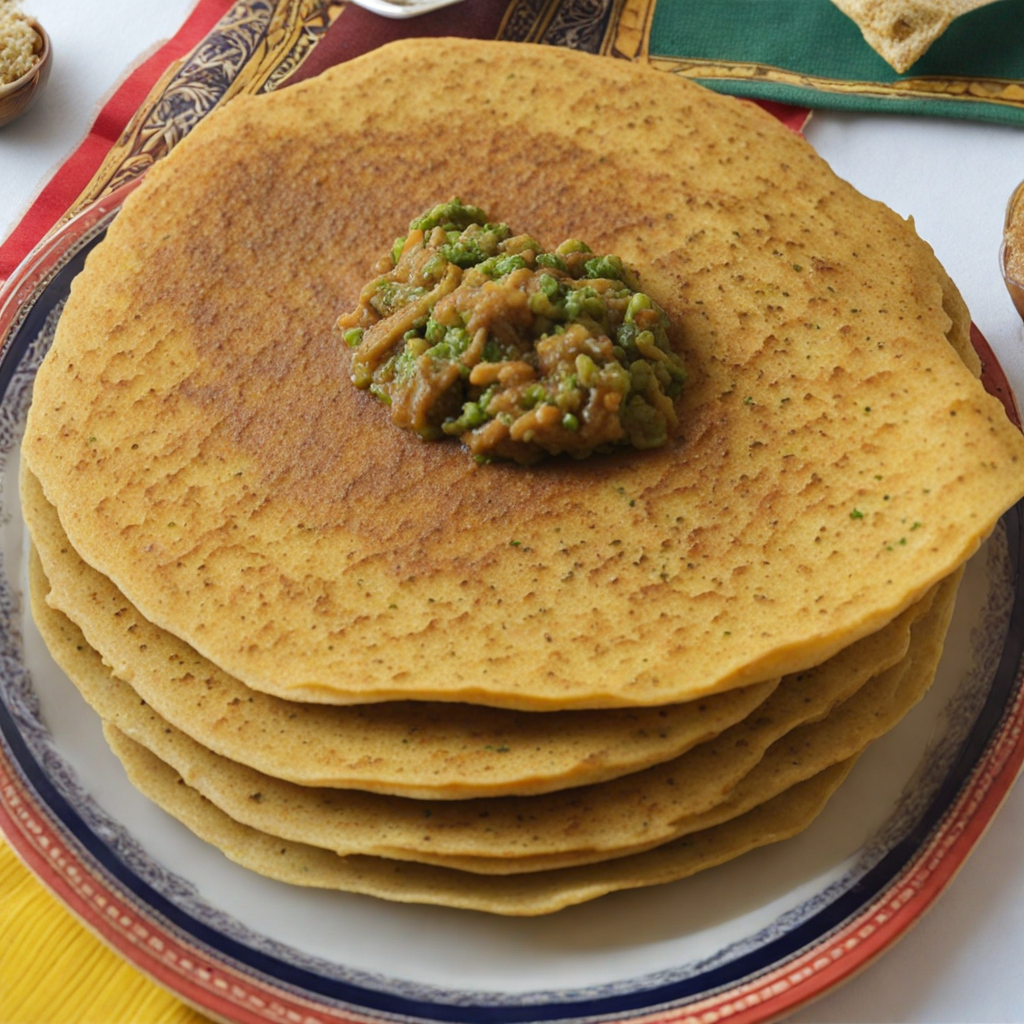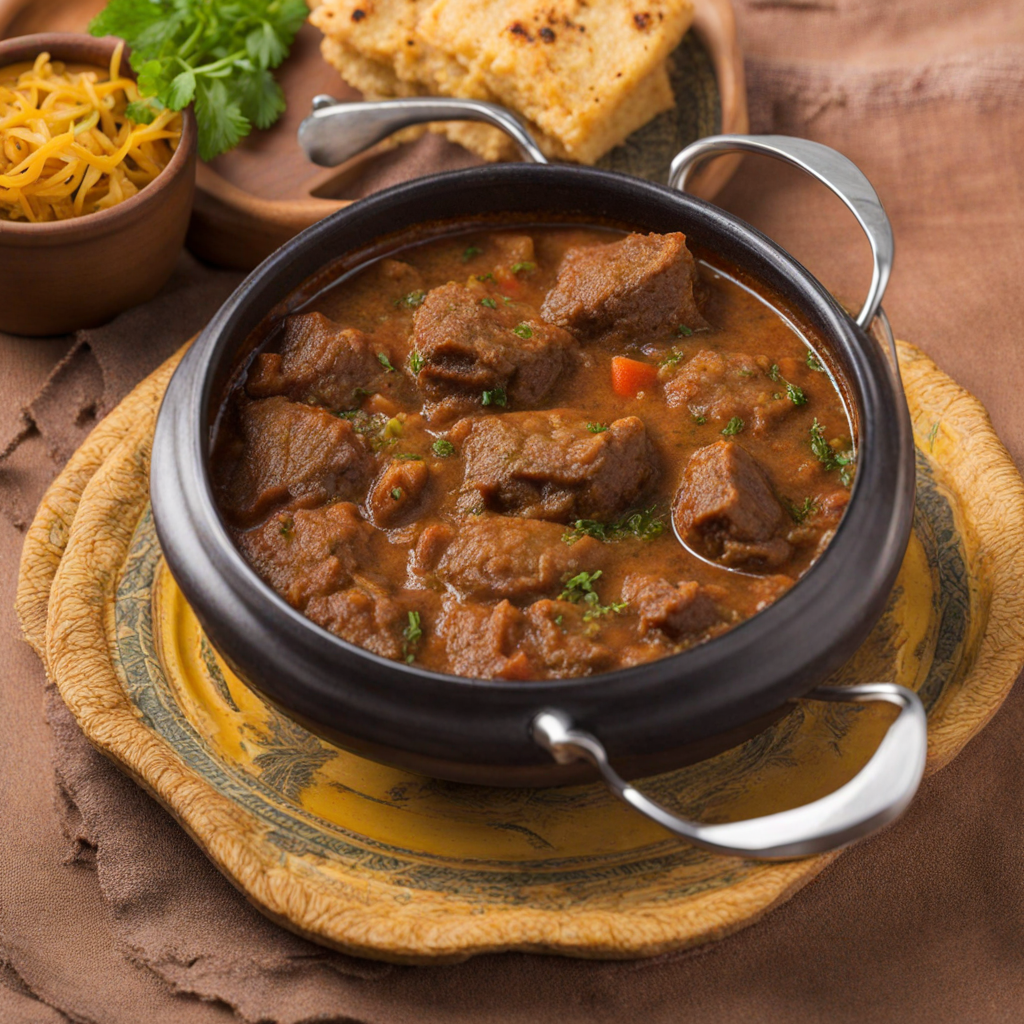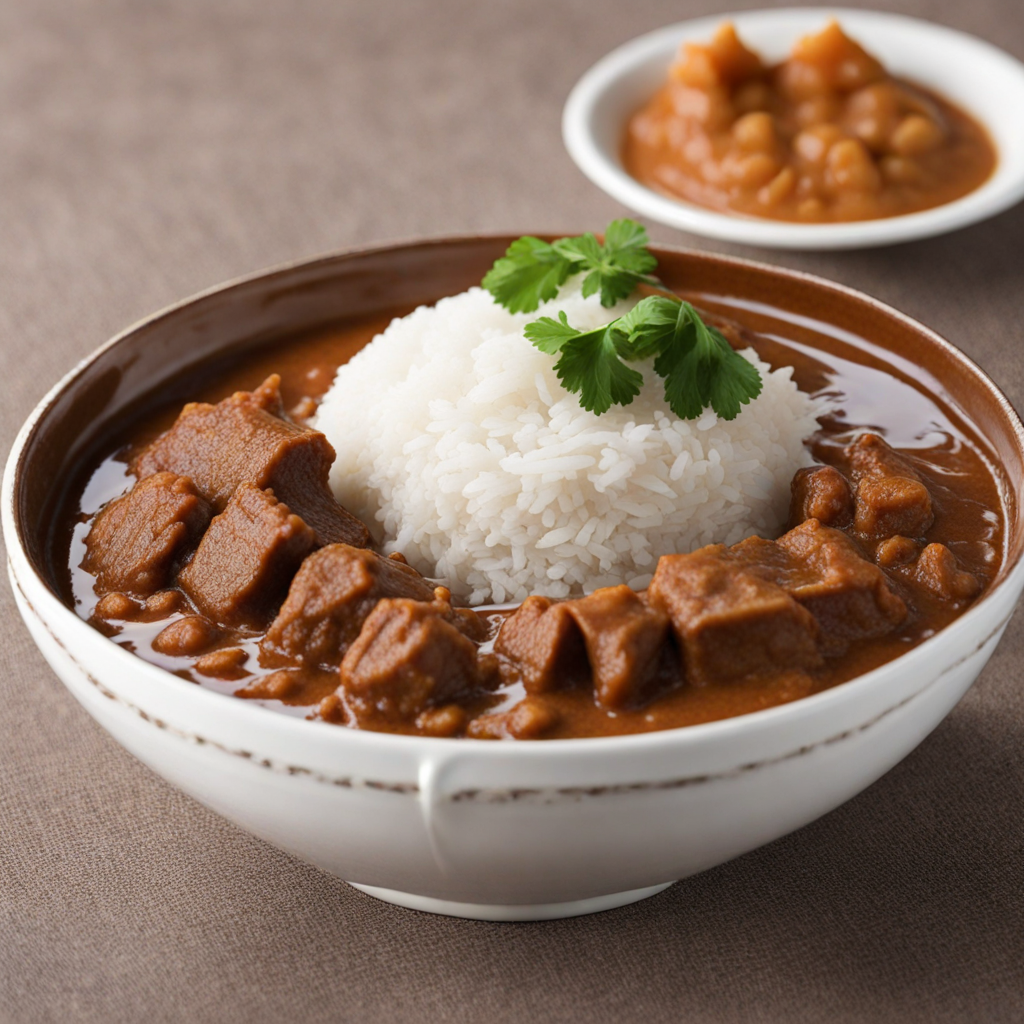Lahoh
Lahoh is a traditional Guinean dish that captivates the palate with its unique texture and subtle flavors. This fermented flatbread, often compared to the Ethiopian injera, is made primarily from rice flour or millet flour, creating a soft, spongy consistency that is perfect for soaking up sauces and stews. The fermentation process gives Lahoh a distinct tangy taste, which is complemented by its light and airy structure, making it an ideal accompaniment to a variety of dishes. The preparation of Lahoh involves mixing the flour with water and a natural leavening agent, allowing it to ferment for several hours or overnight. This fermentation not only develops its characteristic flavor but also enhances its nutritional value, making it a wholesome choice for any meal. Once ready, the batter is cooked on a hot griddle, resulting in large, round pieces that are slightly browned on the edges, while remaining soft and pliable in the center. Lahoh is typically served with a range of flavorful sauces, stews, or grilled meats, allowing diners to scoop up their favorite dishes with the bread. Its versatility makes it a popular choice for both everyday meals and special occasions. The experience of tearing off a piece of Lahoh and using it to enjoy rich, spicy sauces is a culinary adventure that invites one to explore the vibrant flavors of Guinean cuisine.
How It Became This Dish
The Journey of Lahoh: A Culinary Delight from Guinea #### Origins of Lahoh Lahoh, a traditional flatbread from Guinea, traces its roots to the broader Sahelian and West African culinary traditions. While its precise origins remain somewhat murky, Lahoh is believed to have evolved from the practice of unleavened bread-making that spans multiple cultures across the region. The name "Lahoh" itself is derived from the Arabic term "lahuh," which means "thin" or "flat," reflecting its characteristic texture and form. Historically, Lahoh has played an essential role in the diets of many West African communities due to its simplicity, versatility, and nutritional value. It is made primarily from rice flour or millet flour mixed with water to create a batter, which is then cooked on a hot griddle or skillet. This method of preparation has allowed Lahoh to adapt over time, with variations emerging based on local ingredients and cultural preferences. #### Cultural Significance In Guinea, Lahoh is more than just a food item; it is a cultural symbol that embodies the hospitality and communal spirit of the Guinean people. It is often served during important celebrations, family gatherings, and religious festivals. For instance, Lahoh is frequently enjoyed during Eid celebrations, where it is paired with savory dishes or sweet accompaniments. The preparation of Lahoh also serves as a communal activity, bringing families and friends together. Traditionally, women would gather to make Lahoh, sharing stories and laughter while preparing the batter. This social aspect is fundamental to its cultural significance, as it reinforces community bonds and preserves culinary knowledge passed down through generations. Lahoh is typically served with various accompaniments, such as honey, sugar, or traditional stews, making it a versatile dish that can be enjoyed at any time of day. It is often paired with tea or coffee, highlighting the importance of these beverages in Guinean culture and hospitality. #### Development Over Time As Guinea has undergone changes due to globalization, urbanization, and the influence of external culinary traditions, the preparation and consumption of Lahoh have also evolved. In urban areas, for instance, Lahoh may be found in restaurants and food stalls, catering to a growing population that seeks quick and affordable meals. This shift has led to the incorporation of modern cooking techniques and variations in ingredients, such as the addition of spices or the use of different types of flour, including wheat. Despite these changes, traditional Lahoh remains deeply rooted in the cultural identity of the Guinean people. Efforts to preserve and promote this culinary heritage can be seen in the rise of food festivals and cultural events that showcase traditional dishes, including Lahoh. These gatherings not only celebrate local cuisine but also serve as platforms for educating younger generations about the importance of their culinary heritage. In rural areas, the traditional methods of making Lahoh have persisted, with families still preparing it by hand, using locally sourced ingredients. This connection to the land and the reliance on local agricultural practices highlight the sustainability of traditional food systems. The increasing interest in organic and locally sourced foods has further revitalized the appreciation for Lahoh, as people seek to reconnect with their culinary roots. #### Regional Variations While Lahoh is primarily associated with Guinea, it is also found in neighboring countries, albeit with regional variations. In Senegal and Mali, for example, similar flatbreads are made, often referred to as "thieboudienne" or "tô," which incorporate local grains and flavors. These variations showcase the adaptability of Lahoh and its ability to transcend cultural boundaries while maintaining a core identity. The influence of Lahoh can also be seen in the diaspora, where Guineans living abroad have sought to recreate this beloved dish. As they navigate new culinary landscapes, these individuals have introduced Lahoh to diverse audiences, fostering cross-cultural exchanges and expanding its reach beyond West Africa. Food blogs, social media, and cooking classes have become platforms for sharing recipes and stories related to Lahoh, further solidifying its status as a symbol of Guinean identity. #### The Future of Lahoh Looking ahead, the future of Lahoh appears promising, as interest in traditional foods continues to grow. The global trend toward sustainable eating and local sourcing aligns well with the principles behind Lahoh's preparation. As consumers become increasingly aware of the environmental impacts of their food choices, the use of locally sourced, minimally processed ingredients in Lahoh offers a sustainable alternative. Moreover, the revival of interest in heritage foods provides an opportunity for younger generations to engage with their culture through culinary practices. By learning to make Lahoh, they not only preserve a vital aspect of their heritage but also gain a deeper appreciation for the stories, traditions, and values that it represents. This connection to food as a cultural artifact is crucial in a rapidly changing world, where culinary traditions can easily be lost or forgotten. #### Conclusion In summary, Lahoh is not merely a flatbread; it is a culinary emblem of Guinea's rich cultural tapestry. Its origins, cultural significance, and evolution over time reflect the resilience and adaptability of the Guinean people. As Lahoh continues to be celebrated both at home and abroad, it stands as a testament to the enduring power of food as a vehicle for cultural expression and community connection. Through its preparation and consumption, Lahoh remains a delicious reminder of the past while paving the way for future generations to savor and cherish their culinary heritage.
You may like
Discover local flavors from Guinea







